Middle Range Theory and Nursing Shortages: A Healthcare Analysis
VerifiedAdded on 2021/05/30
|9
|2222
|132
Report
AI Summary
This report delves into the application of Middle Range Theory, particularly Patricia Benner's model, to address the pervasive issue of nursing shortages in healthcare settings. The paper begins by outlining the challenges stemming from insufficient resources, skills, and manpower, which often lead to management difficulties, medical errors, and compromised quality of care. It then introduces Benner's five-stage model of clinical competence, from novice to expert, emphasizing the importance of experience, continued learning, and mentorship. The report details the origin of the theory, influenced by the Dreyfus model, and how it has been applied in various clinical scenarios to improve decision-making, learning, and quality assurance. The core of the report focuses on how Benner's theory can be used to mitigate nursing shortages by leveraging the expertise of existing staff, motivating workers, and promoting continuous learning. The model suggests that through mentorship, training, and the sharing of knowledge, hospitals can enhance the skills of nurses, improve their ability to handle increased workloads, and ultimately ensure better patient care despite staffing challenges. The report concludes by highlighting the model's potential to transform nursing practice by fostering interpersonal relationships and enhancing research in the field.
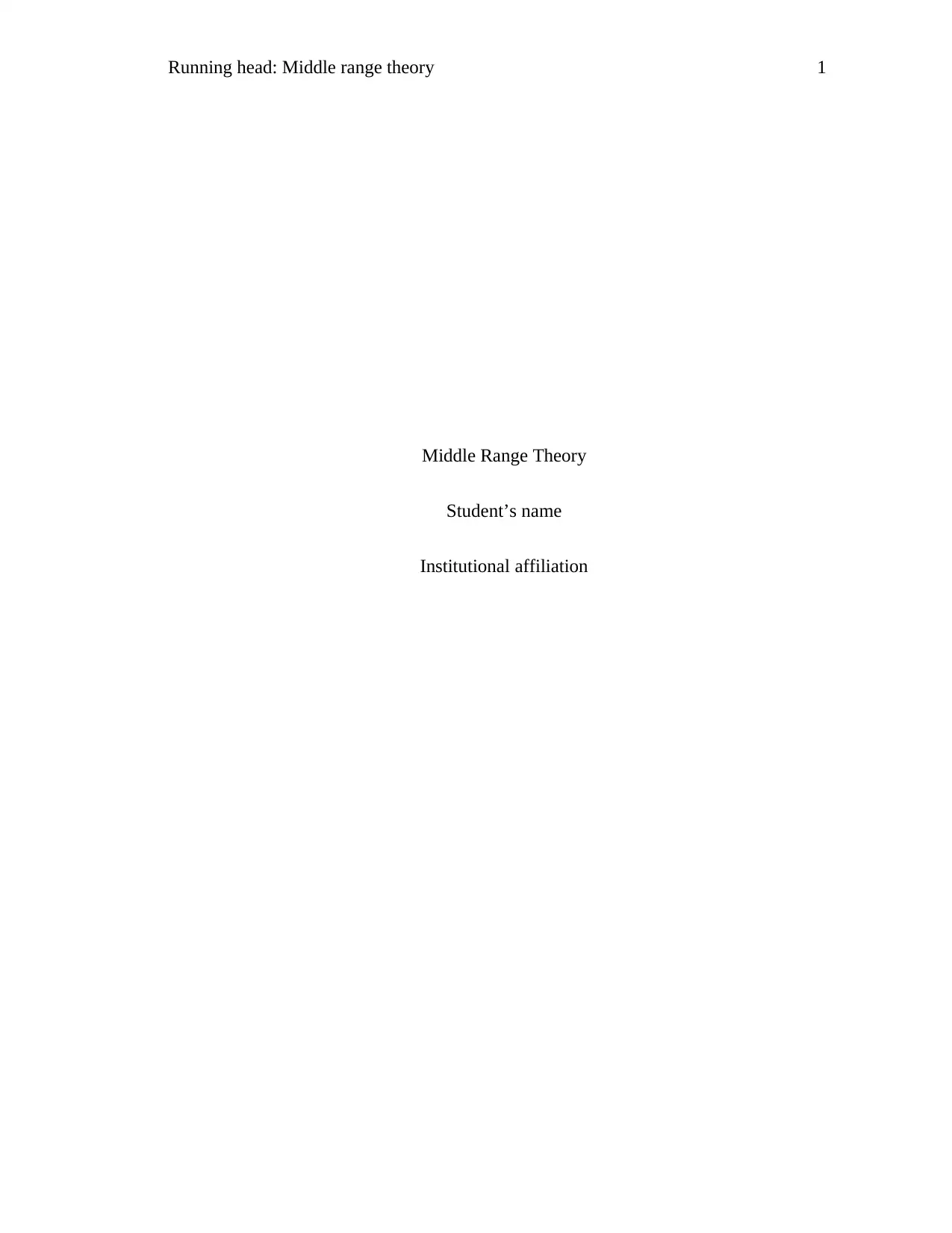
Running head: Middle range theory 1
Middle Range Theory
Student’s name
Institutional affiliation
Middle Range Theory
Student’s name
Institutional affiliation
Paraphrase This Document
Need a fresh take? Get an instant paraphrase of this document with our AI Paraphraser
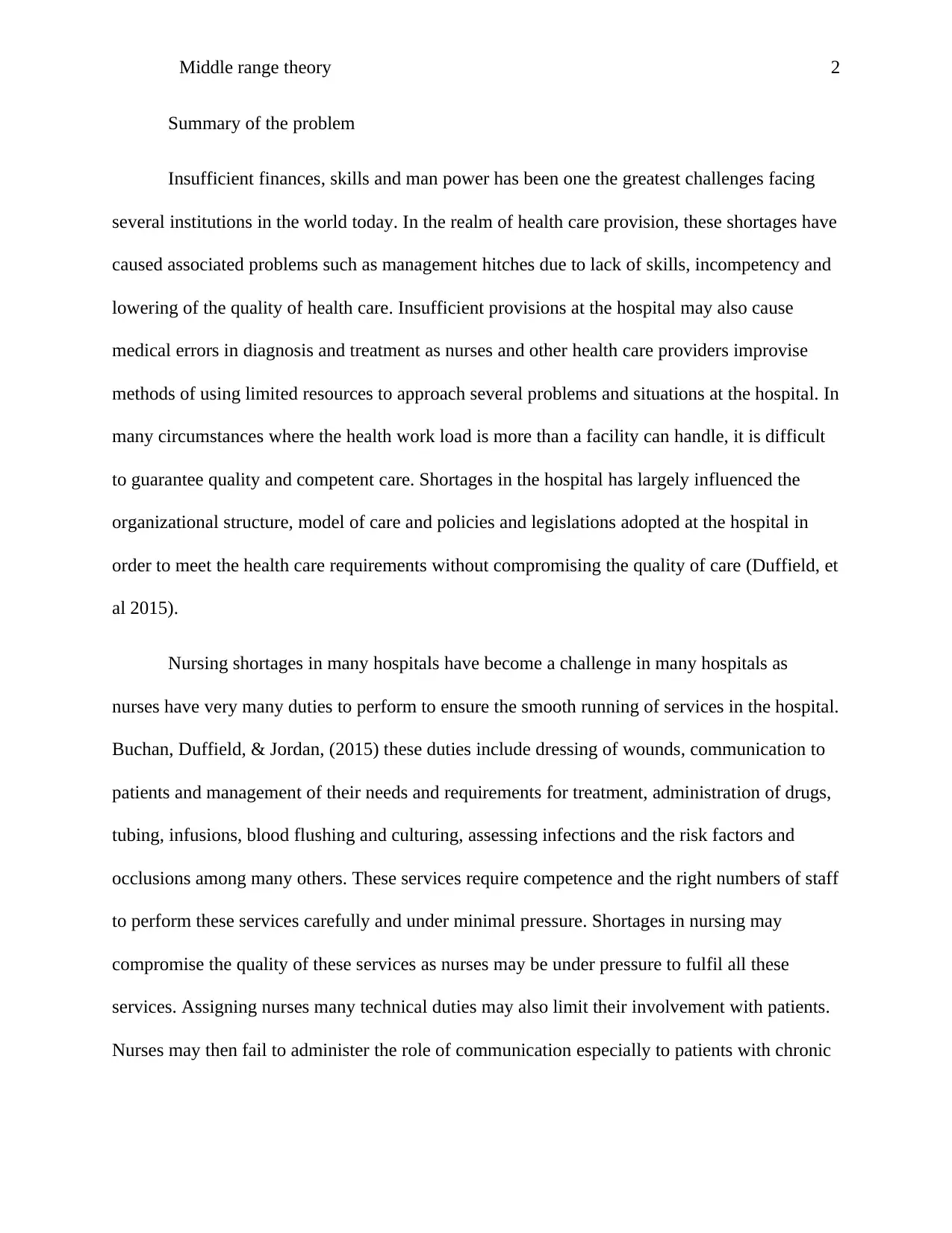
Middle range theory 2
Summary of the problem
Insufficient finances, skills and man power has been one the greatest challenges facing
several institutions in the world today. In the realm of health care provision, these shortages have
caused associated problems such as management hitches due to lack of skills, incompetency and
lowering of the quality of health care. Insufficient provisions at the hospital may also cause
medical errors in diagnosis and treatment as nurses and other health care providers improvise
methods of using limited resources to approach several problems and situations at the hospital. In
many circumstances where the health work load is more than a facility can handle, it is difficult
to guarantee quality and competent care. Shortages in the hospital has largely influenced the
organizational structure, model of care and policies and legislations adopted at the hospital in
order to meet the health care requirements without compromising the quality of care (Duffield, et
al 2015).
Nursing shortages in many hospitals have become a challenge in many hospitals as
nurses have very many duties to perform to ensure the smooth running of services in the hospital.
Buchan, Duffield, & Jordan, (2015) these duties include dressing of wounds, communication to
patients and management of their needs and requirements for treatment, administration of drugs,
tubing, infusions, blood flushing and culturing, assessing infections and the risk factors and
occlusions among many others. These services require competence and the right numbers of staff
to perform these services carefully and under minimal pressure. Shortages in nursing may
compromise the quality of these services as nurses may be under pressure to fulfil all these
services. Assigning nurses many technical duties may also limit their involvement with patients.
Nurses may then fail to administer the role of communication especially to patients with chronic
Summary of the problem
Insufficient finances, skills and man power has been one the greatest challenges facing
several institutions in the world today. In the realm of health care provision, these shortages have
caused associated problems such as management hitches due to lack of skills, incompetency and
lowering of the quality of health care. Insufficient provisions at the hospital may also cause
medical errors in diagnosis and treatment as nurses and other health care providers improvise
methods of using limited resources to approach several problems and situations at the hospital. In
many circumstances where the health work load is more than a facility can handle, it is difficult
to guarantee quality and competent care. Shortages in the hospital has largely influenced the
organizational structure, model of care and policies and legislations adopted at the hospital in
order to meet the health care requirements without compromising the quality of care (Duffield, et
al 2015).
Nursing shortages in many hospitals have become a challenge in many hospitals as
nurses have very many duties to perform to ensure the smooth running of services in the hospital.
Buchan, Duffield, & Jordan, (2015) these duties include dressing of wounds, communication to
patients and management of their needs and requirements for treatment, administration of drugs,
tubing, infusions, blood flushing and culturing, assessing infections and the risk factors and
occlusions among many others. These services require competence and the right numbers of staff
to perform these services carefully and under minimal pressure. Shortages in nursing may
compromise the quality of these services as nurses may be under pressure to fulfil all these
services. Assigning nurses many technical duties may also limit their involvement with patients.
Nurses may then fail to administer the role of communication especially to patients with chronic
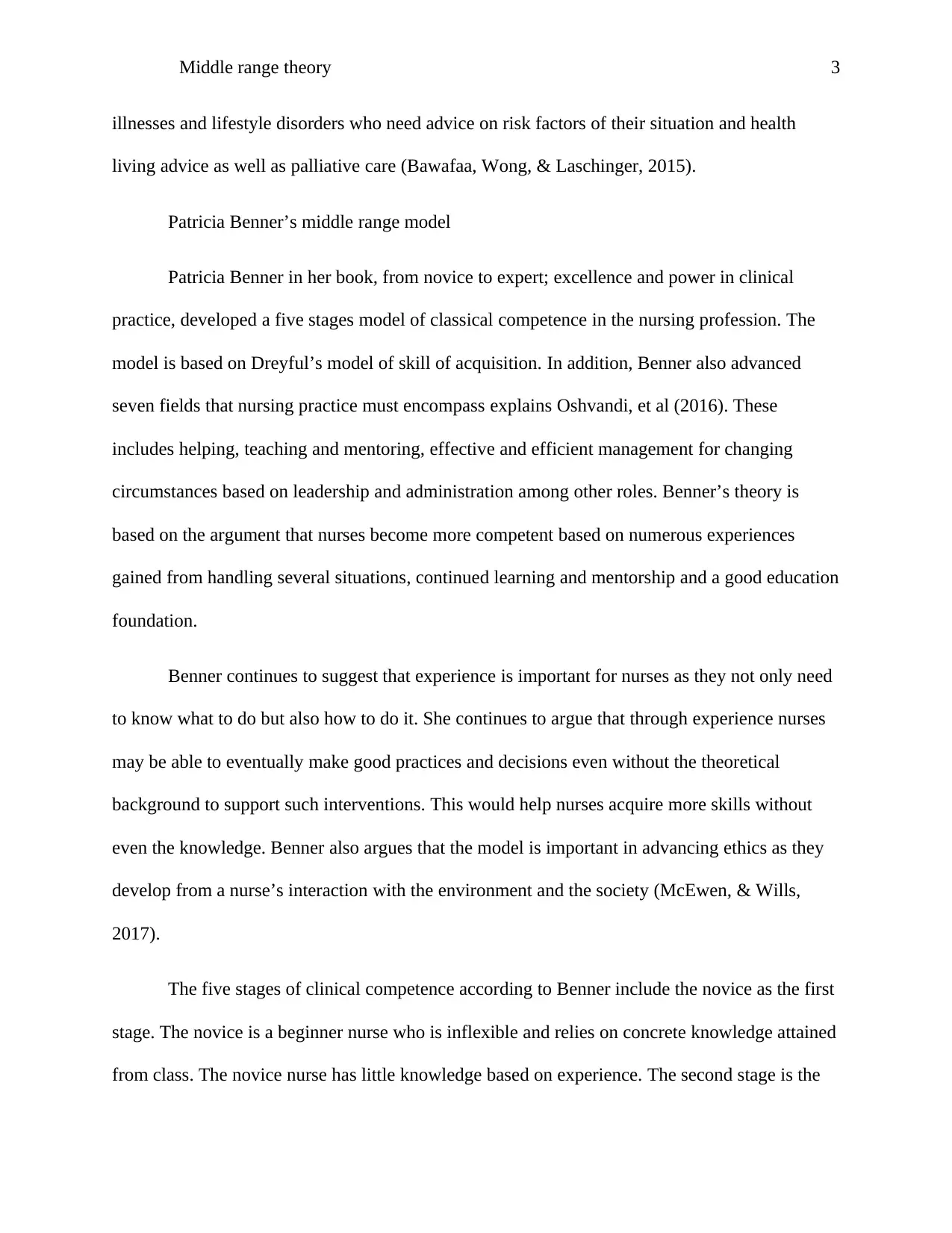
Middle range theory 3
illnesses and lifestyle disorders who need advice on risk factors of their situation and health
living advice as well as palliative care (Bawafaa, Wong, & Laschinger, 2015).
Patricia Benner’s middle range model
Patricia Benner in her book, from novice to expert; excellence and power in clinical
practice, developed a five stages model of classical competence in the nursing profession. The
model is based on Dreyful’s model of skill of acquisition. In addition, Benner also advanced
seven fields that nursing practice must encompass explains Oshvandi, et al (2016). These
includes helping, teaching and mentoring, effective and efficient management for changing
circumstances based on leadership and administration among other roles. Benner’s theory is
based on the argument that nurses become more competent based on numerous experiences
gained from handling several situations, continued learning and mentorship and a good education
foundation.
Benner continues to suggest that experience is important for nurses as they not only need
to know what to do but also how to do it. She continues to argue that through experience nurses
may be able to eventually make good practices and decisions even without the theoretical
background to support such interventions. This would help nurses acquire more skills without
even the knowledge. Benner also argues that the model is important in advancing ethics as they
develop from a nurse’s interaction with the environment and the society (McEwen, & Wills,
2017).
The five stages of clinical competence according to Benner include the novice as the first
stage. The novice is a beginner nurse who is inflexible and relies on concrete knowledge attained
from class. The novice nurse has little knowledge based on experience. The second stage is the
illnesses and lifestyle disorders who need advice on risk factors of their situation and health
living advice as well as palliative care (Bawafaa, Wong, & Laschinger, 2015).
Patricia Benner’s middle range model
Patricia Benner in her book, from novice to expert; excellence and power in clinical
practice, developed a five stages model of classical competence in the nursing profession. The
model is based on Dreyful’s model of skill of acquisition. In addition, Benner also advanced
seven fields that nursing practice must encompass explains Oshvandi, et al (2016). These
includes helping, teaching and mentoring, effective and efficient management for changing
circumstances based on leadership and administration among other roles. Benner’s theory is
based on the argument that nurses become more competent based on numerous experiences
gained from handling several situations, continued learning and mentorship and a good education
foundation.
Benner continues to suggest that experience is important for nurses as they not only need
to know what to do but also how to do it. She continues to argue that through experience nurses
may be able to eventually make good practices and decisions even without the theoretical
background to support such interventions. This would help nurses acquire more skills without
even the knowledge. Benner also argues that the model is important in advancing ethics as they
develop from a nurse’s interaction with the environment and the society (McEwen, & Wills,
2017).
The five stages of clinical competence according to Benner include the novice as the first
stage. The novice is a beginner nurse who is inflexible and relies on concrete knowledge attained
from class. The novice nurse has little knowledge based on experience. The second stage is the
⊘ This is a preview!⊘
Do you want full access?
Subscribe today to unlock all pages.

Trusted by 1+ million students worldwide
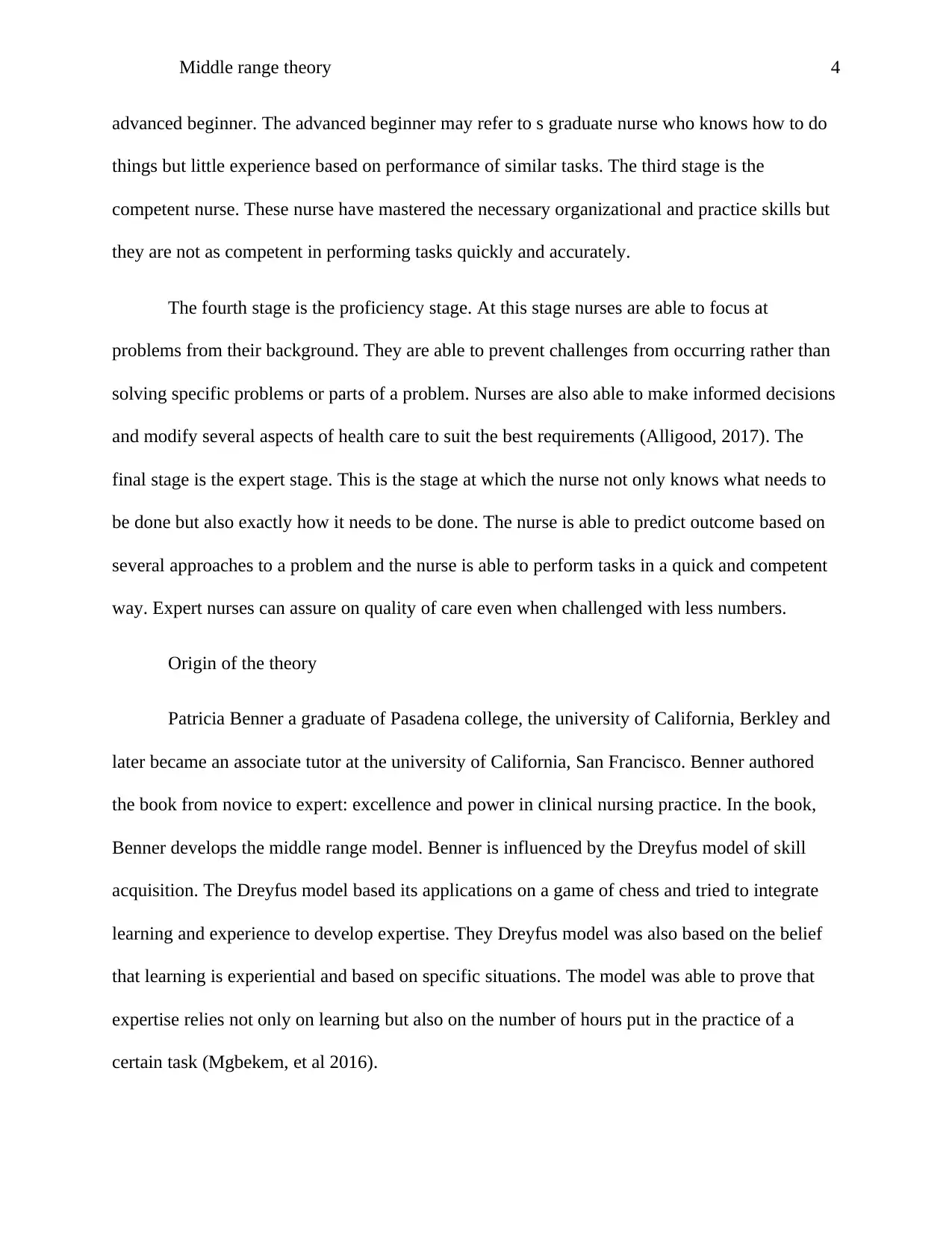
Middle range theory 4
advanced beginner. The advanced beginner may refer to s graduate nurse who knows how to do
things but little experience based on performance of similar tasks. The third stage is the
competent nurse. These nurse have mastered the necessary organizational and practice skills but
they are not as competent in performing tasks quickly and accurately.
The fourth stage is the proficiency stage. At this stage nurses are able to focus at
problems from their background. They are able to prevent challenges from occurring rather than
solving specific problems or parts of a problem. Nurses are also able to make informed decisions
and modify several aspects of health care to suit the best requirements (Alligood, 2017). The
final stage is the expert stage. This is the stage at which the nurse not only knows what needs to
be done but also exactly how it needs to be done. The nurse is able to predict outcome based on
several approaches to a problem and the nurse is able to perform tasks in a quick and competent
way. Expert nurses can assure on quality of care even when challenged with less numbers.
Origin of the theory
Patricia Benner a graduate of Pasadena college, the university of California, Berkley and
later became an associate tutor at the university of California, San Francisco. Benner authored
the book from novice to expert: excellence and power in clinical nursing practice. In the book,
Benner develops the middle range model. Benner is influenced by the Dreyfus model of skill
acquisition. The Dreyfus model based its applications on a game of chess and tried to integrate
learning and experience to develop expertise. They Dreyfus model was also based on the belief
that learning is experiential and based on specific situations. The model was able to prove that
expertise relies not only on learning but also on the number of hours put in the practice of a
certain task (Mgbekem, et al 2016).
advanced beginner. The advanced beginner may refer to s graduate nurse who knows how to do
things but little experience based on performance of similar tasks. The third stage is the
competent nurse. These nurse have mastered the necessary organizational and practice skills but
they are not as competent in performing tasks quickly and accurately.
The fourth stage is the proficiency stage. At this stage nurses are able to focus at
problems from their background. They are able to prevent challenges from occurring rather than
solving specific problems or parts of a problem. Nurses are also able to make informed decisions
and modify several aspects of health care to suit the best requirements (Alligood, 2017). The
final stage is the expert stage. This is the stage at which the nurse not only knows what needs to
be done but also exactly how it needs to be done. The nurse is able to predict outcome based on
several approaches to a problem and the nurse is able to perform tasks in a quick and competent
way. Expert nurses can assure on quality of care even when challenged with less numbers.
Origin of the theory
Patricia Benner a graduate of Pasadena college, the university of California, Berkley and
later became an associate tutor at the university of California, San Francisco. Benner authored
the book from novice to expert: excellence and power in clinical nursing practice. In the book,
Benner develops the middle range model. Benner is influenced by the Dreyfus model of skill
acquisition. The Dreyfus model based its applications on a game of chess and tried to integrate
learning and experience to develop expertise. They Dreyfus model was also based on the belief
that learning is experiential and based on specific situations. The model was able to prove that
expertise relies not only on learning but also on the number of hours put in the practice of a
certain task (Mgbekem, et al 2016).
Paraphrase This Document
Need a fresh take? Get an instant paraphrase of this document with our AI Paraphraser
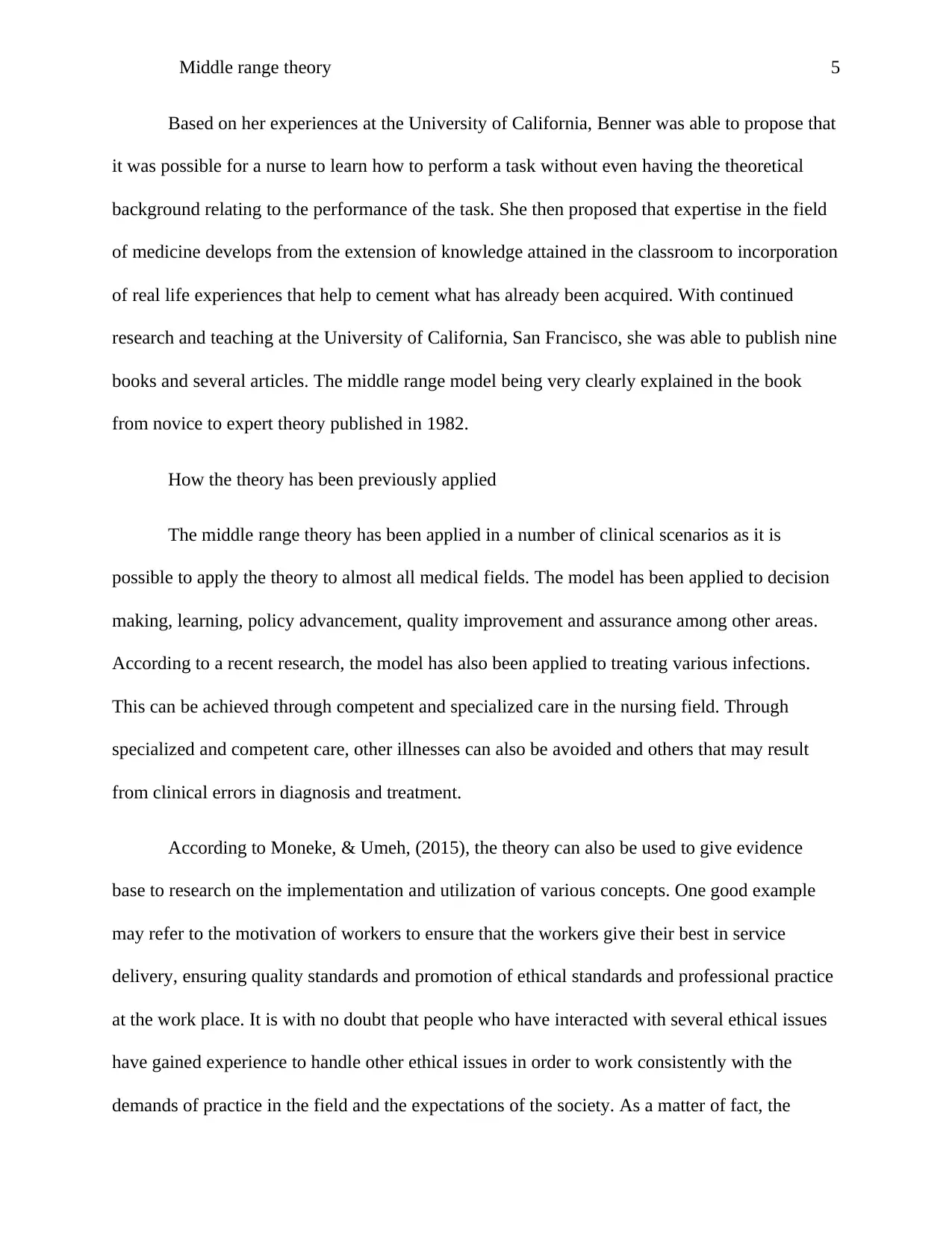
Middle range theory 5
Based on her experiences at the University of California, Benner was able to propose that
it was possible for a nurse to learn how to perform a task without even having the theoretical
background relating to the performance of the task. She then proposed that expertise in the field
of medicine develops from the extension of knowledge attained in the classroom to incorporation
of real life experiences that help to cement what has already been acquired. With continued
research and teaching at the University of California, San Francisco, she was able to publish nine
books and several articles. The middle range model being very clearly explained in the book
from novice to expert theory published in 1982.
How the theory has been previously applied
The middle range theory has been applied in a number of clinical scenarios as it is
possible to apply the theory to almost all medical fields. The model has been applied to decision
making, learning, policy advancement, quality improvement and assurance among other areas.
According to a recent research, the model has also been applied to treating various infections.
This can be achieved through competent and specialized care in the nursing field. Through
specialized and competent care, other illnesses can also be avoided and others that may result
from clinical errors in diagnosis and treatment.
According to Moneke, & Umeh, (2015), the theory can also be used to give evidence
base to research on the implementation and utilization of various concepts. One good example
may refer to the motivation of workers to ensure that the workers give their best in service
delivery, ensuring quality standards and promotion of ethical standards and professional practice
at the work place. It is with no doubt that people who have interacted with several ethical issues
have gained experience to handle other ethical issues in order to work consistently with the
demands of practice in the field and the expectations of the society. As a matter of fact, the
Based on her experiences at the University of California, Benner was able to propose that
it was possible for a nurse to learn how to perform a task without even having the theoretical
background relating to the performance of the task. She then proposed that expertise in the field
of medicine develops from the extension of knowledge attained in the classroom to incorporation
of real life experiences that help to cement what has already been acquired. With continued
research and teaching at the University of California, San Francisco, she was able to publish nine
books and several articles. The middle range model being very clearly explained in the book
from novice to expert theory published in 1982.
How the theory has been previously applied
The middle range theory has been applied in a number of clinical scenarios as it is
possible to apply the theory to almost all medical fields. The model has been applied to decision
making, learning, policy advancement, quality improvement and assurance among other areas.
According to a recent research, the model has also been applied to treating various infections.
This can be achieved through competent and specialized care in the nursing field. Through
specialized and competent care, other illnesses can also be avoided and others that may result
from clinical errors in diagnosis and treatment.
According to Moneke, & Umeh, (2015), the theory can also be used to give evidence
base to research on the implementation and utilization of various concepts. One good example
may refer to the motivation of workers to ensure that the workers give their best in service
delivery, ensuring quality standards and promotion of ethical standards and professional practice
at the work place. It is with no doubt that people who have interacted with several ethical issues
have gained experience to handle other ethical issues in order to work consistently with the
demands of practice in the field and the expectations of the society. As a matter of fact, the
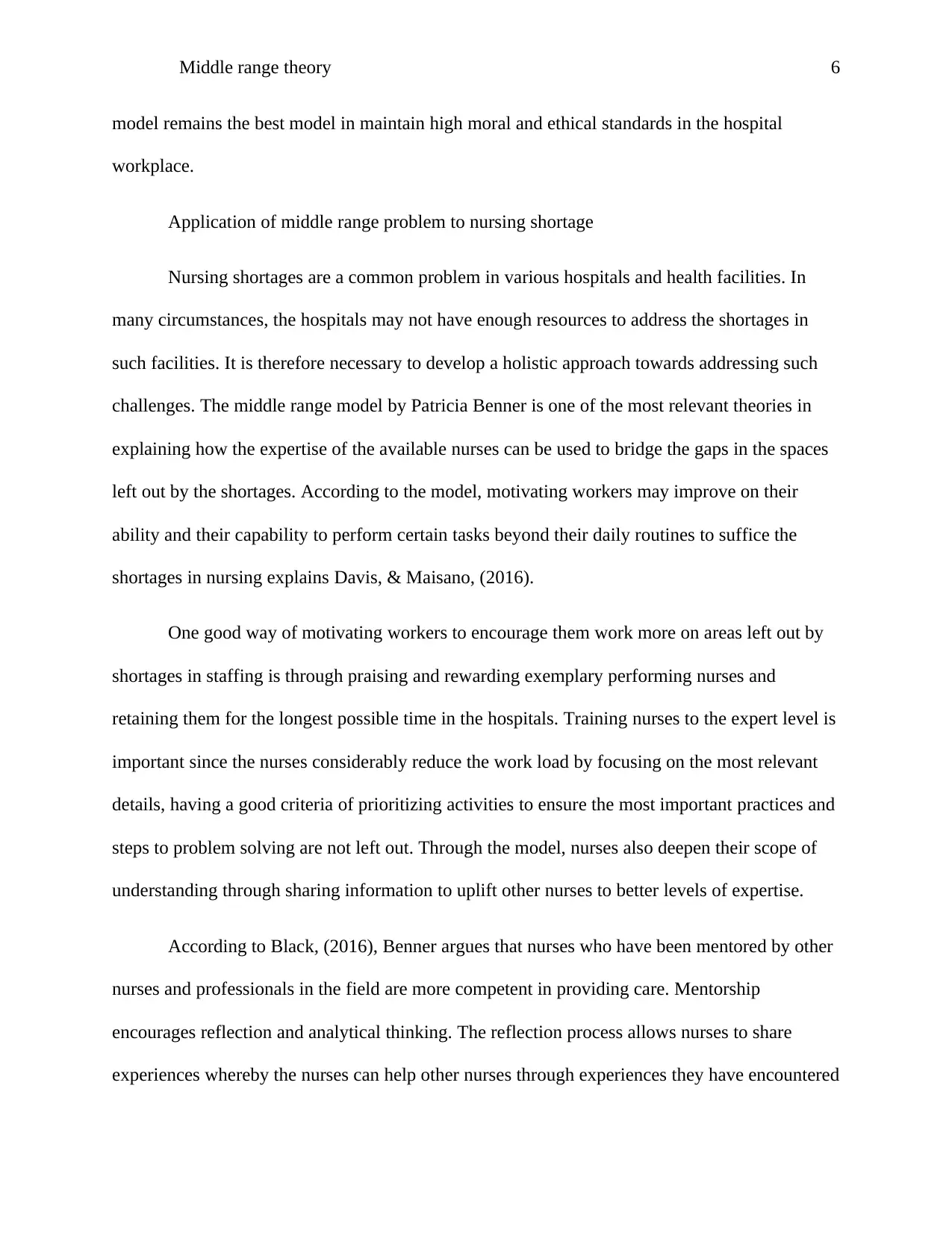
Middle range theory 6
model remains the best model in maintain high moral and ethical standards in the hospital
workplace.
Application of middle range problem to nursing shortage
Nursing shortages are a common problem in various hospitals and health facilities. In
many circumstances, the hospitals may not have enough resources to address the shortages in
such facilities. It is therefore necessary to develop a holistic approach towards addressing such
challenges. The middle range model by Patricia Benner is one of the most relevant theories in
explaining how the expertise of the available nurses can be used to bridge the gaps in the spaces
left out by the shortages. According to the model, motivating workers may improve on their
ability and their capability to perform certain tasks beyond their daily routines to suffice the
shortages in nursing explains Davis, & Maisano, (2016).
One good way of motivating workers to encourage them work more on areas left out by
shortages in staffing is through praising and rewarding exemplary performing nurses and
retaining them for the longest possible time in the hospitals. Training nurses to the expert level is
important since the nurses considerably reduce the work load by focusing on the most relevant
details, having a good criteria of prioritizing activities to ensure the most important practices and
steps to problem solving are not left out. Through the model, nurses also deepen their scope of
understanding through sharing information to uplift other nurses to better levels of expertise.
According to Black, (2016), Benner argues that nurses who have been mentored by other
nurses and professionals in the field are more competent in providing care. Mentorship
encourages reflection and analytical thinking. The reflection process allows nurses to share
experiences whereby the nurses can help other nurses through experiences they have encountered
model remains the best model in maintain high moral and ethical standards in the hospital
workplace.
Application of middle range problem to nursing shortage
Nursing shortages are a common problem in various hospitals and health facilities. In
many circumstances, the hospitals may not have enough resources to address the shortages in
such facilities. It is therefore necessary to develop a holistic approach towards addressing such
challenges. The middle range model by Patricia Benner is one of the most relevant theories in
explaining how the expertise of the available nurses can be used to bridge the gaps in the spaces
left out by the shortages. According to the model, motivating workers may improve on their
ability and their capability to perform certain tasks beyond their daily routines to suffice the
shortages in nursing explains Davis, & Maisano, (2016).
One good way of motivating workers to encourage them work more on areas left out by
shortages in staffing is through praising and rewarding exemplary performing nurses and
retaining them for the longest possible time in the hospitals. Training nurses to the expert level is
important since the nurses considerably reduce the work load by focusing on the most relevant
details, having a good criteria of prioritizing activities to ensure the most important practices and
steps to problem solving are not left out. Through the model, nurses also deepen their scope of
understanding through sharing information to uplift other nurses to better levels of expertise.
According to Black, (2016), Benner argues that nurses who have been mentored by other
nurses and professionals in the field are more competent in providing care. Mentorship
encourages reflection and analytical thinking. The reflection process allows nurses to share
experiences whereby the nurses can help other nurses through experiences they have encountered
⊘ This is a preview!⊘
Do you want full access?
Subscribe today to unlock all pages.

Trusted by 1+ million students worldwide
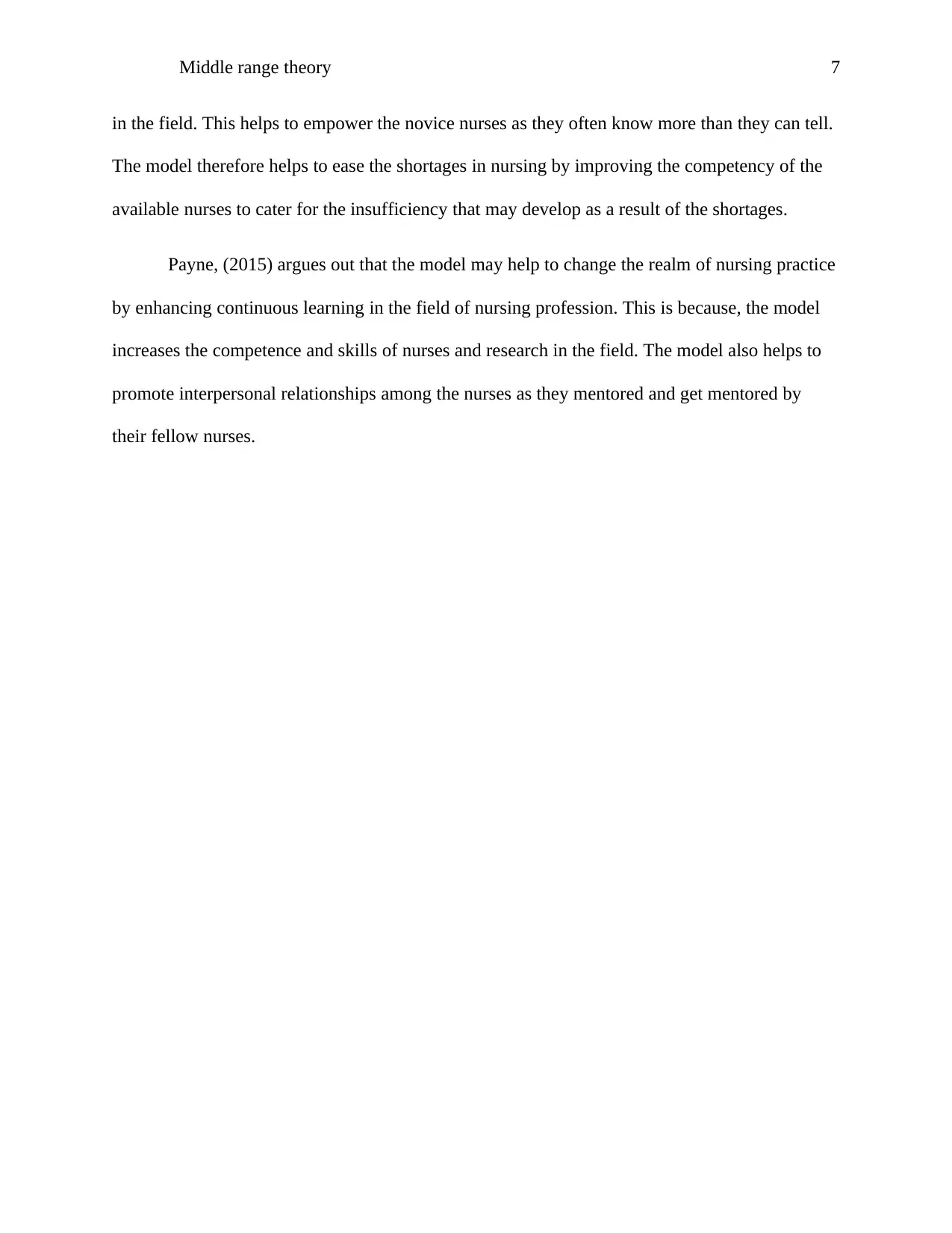
Middle range theory 7
in the field. This helps to empower the novice nurses as they often know more than they can tell.
The model therefore helps to ease the shortages in nursing by improving the competency of the
available nurses to cater for the insufficiency that may develop as a result of the shortages.
Payne, (2015) argues out that the model may help to change the realm of nursing practice
by enhancing continuous learning in the field of nursing profession. This is because, the model
increases the competence and skills of nurses and research in the field. The model also helps to
promote interpersonal relationships among the nurses as they mentored and get mentored by
their fellow nurses.
in the field. This helps to empower the novice nurses as they often know more than they can tell.
The model therefore helps to ease the shortages in nursing by improving the competency of the
available nurses to cater for the insufficiency that may develop as a result of the shortages.
Payne, (2015) argues out that the model may help to change the realm of nursing practice
by enhancing continuous learning in the field of nursing profession. This is because, the model
increases the competence and skills of nurses and research in the field. The model also helps to
promote interpersonal relationships among the nurses as they mentored and get mentored by
their fellow nurses.
Paraphrase This Document
Need a fresh take? Get an instant paraphrase of this document with our AI Paraphraser
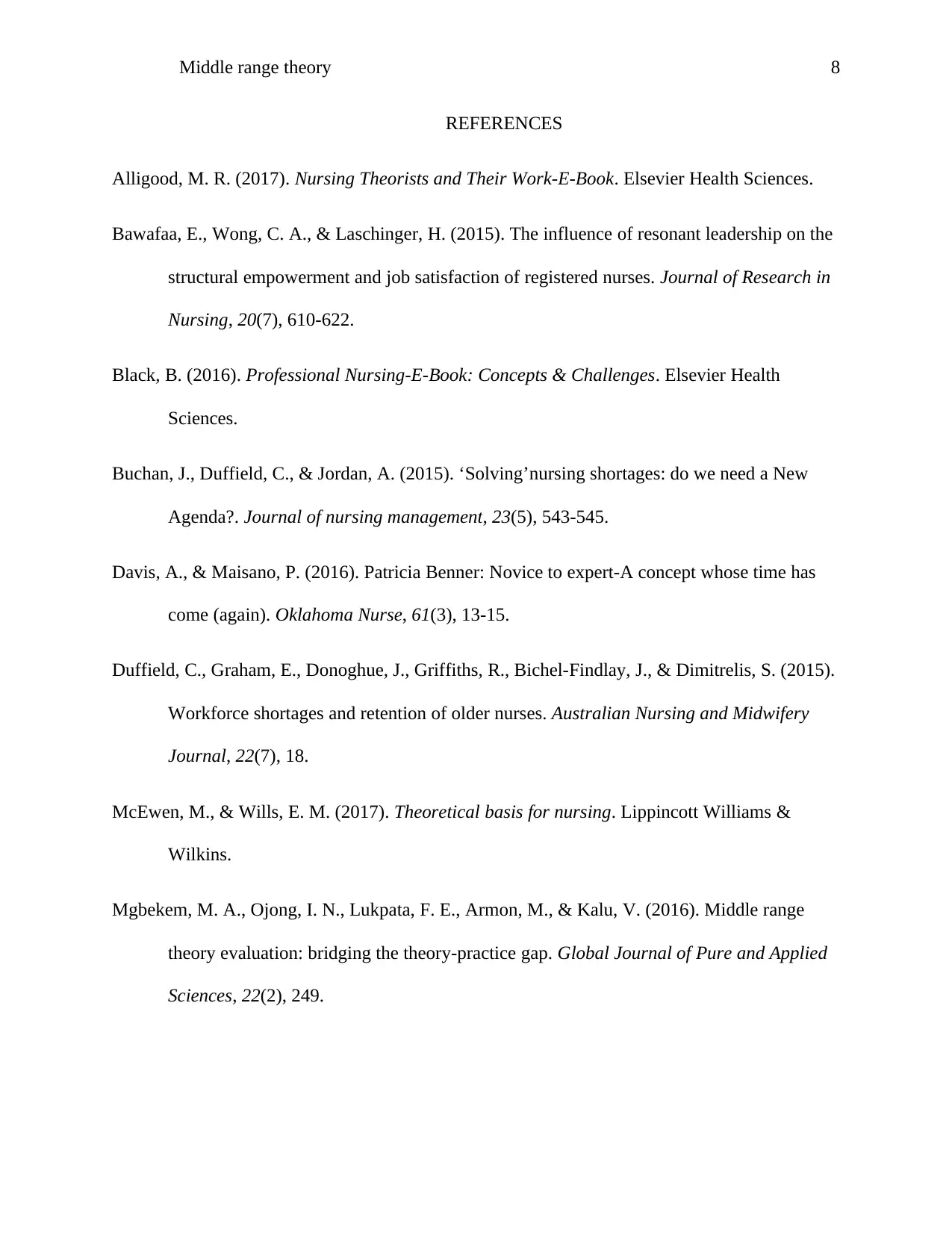
Middle range theory 8
REFERENCES
Alligood, M. R. (2017). Nursing Theorists and Their Work-E-Book. Elsevier Health Sciences.
Bawafaa, E., Wong, C. A., & Laschinger, H. (2015). The influence of resonant leadership on the
structural empowerment and job satisfaction of registered nurses. Journal of Research in
Nursing, 20(7), 610-622.
Black, B. (2016). Professional Nursing-E-Book: Concepts & Challenges. Elsevier Health
Sciences.
Buchan, J., Duffield, C., & Jordan, A. (2015). ‘Solving’nursing shortages: do we need a New
Agenda?. Journal of nursing management, 23(5), 543-545.
Davis, A., & Maisano, P. (2016). Patricia Benner: Novice to expert-A concept whose time has
come (again). Oklahoma Nurse, 61(3), 13-15.
Duffield, C., Graham, E., Donoghue, J., Griffiths, R., Bichel-Findlay, J., & Dimitrelis, S. (2015).
Workforce shortages and retention of older nurses. Australian Nursing and Midwifery
Journal, 22(7), 18.
McEwen, M., & Wills, E. M. (2017). Theoretical basis for nursing. Lippincott Williams &
Wilkins.
Mgbekem, M. A., Ojong, I. N., Lukpata, F. E., Armon, M., & Kalu, V. (2016). Middle range
theory evaluation: bridging the theory-practice gap. Global Journal of Pure and Applied
Sciences, 22(2), 249.
REFERENCES
Alligood, M. R. (2017). Nursing Theorists and Their Work-E-Book. Elsevier Health Sciences.
Bawafaa, E., Wong, C. A., & Laschinger, H. (2015). The influence of resonant leadership on the
structural empowerment and job satisfaction of registered nurses. Journal of Research in
Nursing, 20(7), 610-622.
Black, B. (2016). Professional Nursing-E-Book: Concepts & Challenges. Elsevier Health
Sciences.
Buchan, J., Duffield, C., & Jordan, A. (2015). ‘Solving’nursing shortages: do we need a New
Agenda?. Journal of nursing management, 23(5), 543-545.
Davis, A., & Maisano, P. (2016). Patricia Benner: Novice to expert-A concept whose time has
come (again). Oklahoma Nurse, 61(3), 13-15.
Duffield, C., Graham, E., Donoghue, J., Griffiths, R., Bichel-Findlay, J., & Dimitrelis, S. (2015).
Workforce shortages and retention of older nurses. Australian Nursing and Midwifery
Journal, 22(7), 18.
McEwen, M., & Wills, E. M. (2017). Theoretical basis for nursing. Lippincott Williams &
Wilkins.
Mgbekem, M. A., Ojong, I. N., Lukpata, F. E., Armon, M., & Kalu, V. (2016). Middle range
theory evaluation: bridging the theory-practice gap. Global Journal of Pure and Applied
Sciences, 22(2), 249.
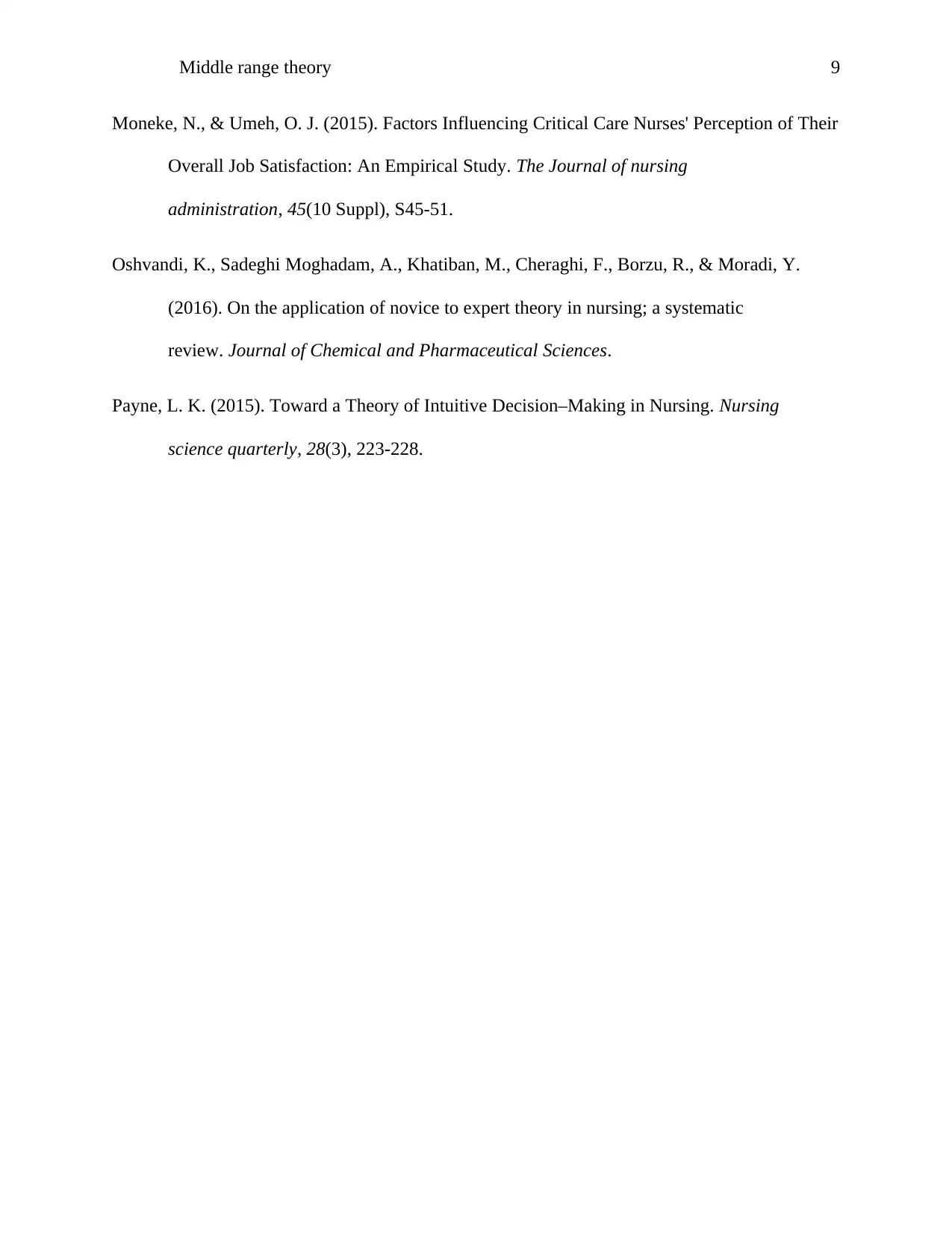
Middle range theory 9
Moneke, N., & Umeh, O. J. (2015). Factors Influencing Critical Care Nurses' Perception of Their
Overall Job Satisfaction: An Empirical Study. The Journal of nursing
administration, 45(10 Suppl), S45-51.
Oshvandi, K., Sadeghi Moghadam, A., Khatiban, M., Cheraghi, F., Borzu, R., & Moradi, Y.
(2016). On the application of novice to expert theory in nursing; a systematic
review. Journal of Chemical and Pharmaceutical Sciences.
Payne, L. K. (2015). Toward a Theory of Intuitive Decision–Making in Nursing. Nursing
science quarterly, 28(3), 223-228.
Moneke, N., & Umeh, O. J. (2015). Factors Influencing Critical Care Nurses' Perception of Their
Overall Job Satisfaction: An Empirical Study. The Journal of nursing
administration, 45(10 Suppl), S45-51.
Oshvandi, K., Sadeghi Moghadam, A., Khatiban, M., Cheraghi, F., Borzu, R., & Moradi, Y.
(2016). On the application of novice to expert theory in nursing; a systematic
review. Journal of Chemical and Pharmaceutical Sciences.
Payne, L. K. (2015). Toward a Theory of Intuitive Decision–Making in Nursing. Nursing
science quarterly, 28(3), 223-228.
⊘ This is a preview!⊘
Do you want full access?
Subscribe today to unlock all pages.

Trusted by 1+ million students worldwide
1 out of 9
Related Documents
Your All-in-One AI-Powered Toolkit for Academic Success.
+13062052269
info@desklib.com
Available 24*7 on WhatsApp / Email
![[object Object]](/_next/static/media/star-bottom.7253800d.svg)
Unlock your academic potential
Copyright © 2020–2025 A2Z Services. All Rights Reserved. Developed and managed by ZUCOL.





